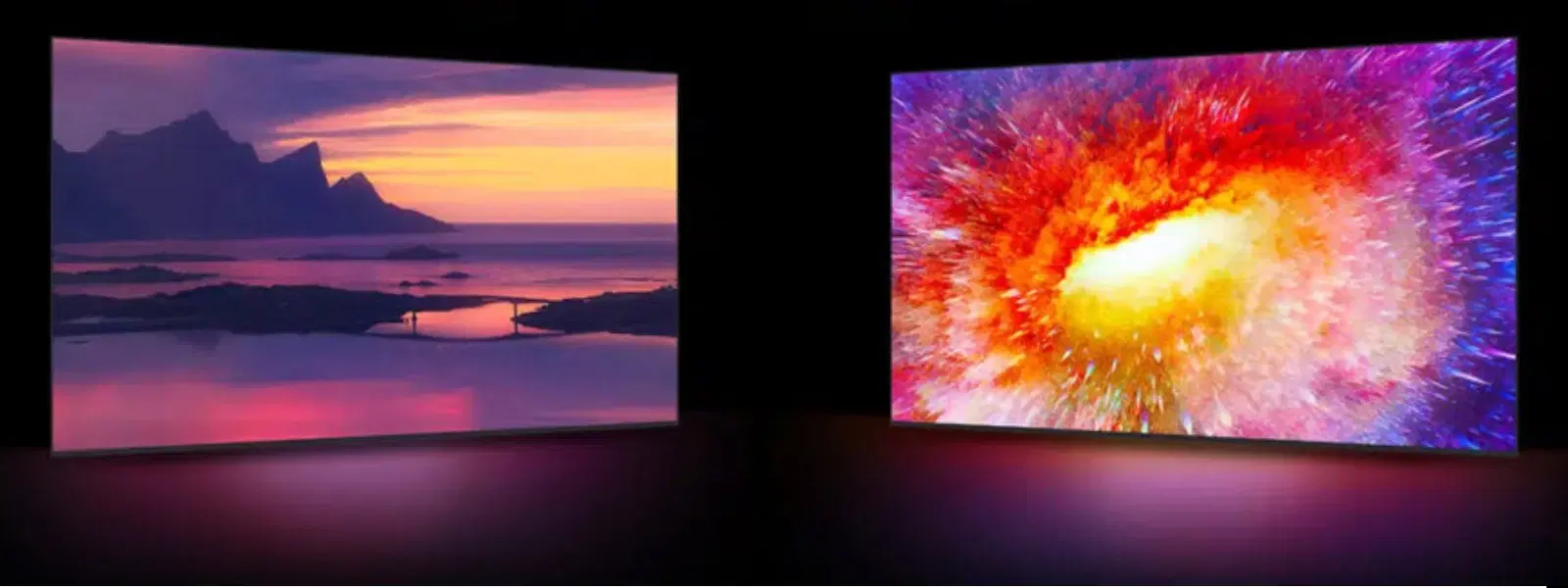
Consumer Electronics
•03 min read

Buy SAMSUNG 8 Series 247 cm (98 inch) QLED 4K Ultra HD Tizen TV with Dolby Atmos (2023 model) online at best prices from Croma. Check product details, reviews & more. Shop now!
Picture yourself entering a store filled with an array of sleek, modern televisions. You notice the labels QLED and OLED, and naturally, questions arise. This guide unravels the key differences between these two technologies, helping you understand which one fits your lifestyle best. Whether you are a gaming enthusiast, a movie buff, or looking for a TV suitable for everyday viewing, this read promises clear insights in simple language.
QLED, or Quantum Dot Light Emitting Diode, is an enhanced version of traditional LED TVs. It uses a backlighting system combined with quantum dots to deliver vibrant colours, making it ideal for rooms with plenty of natural light. On the other hand, OLED, which stands for Organic Light Emitting Diode, features self-illuminating pixels. This means each pixel lights up independently, allowing for true blacks, superior contrast and that immersive viewing experience.
The fundamental difference lies in illumination; while QLED relies on backlighting, OLED’s pixels are self-sufficient. Both technologies offer outstanding resolution and colour accuracy, but the way they produce light sets them apart.
When comparing picture quality, OLED TVs are renowned for their deep blacks and excellent contrast, making them particularly appealing in darker environments, such as home theatre setups. QLED TVs, with their impressive brightness levels, shine in well-lit spaces. This high brightness is especially beneficial in rooms flooded with daylight, ensuring that the picture remains striking and vivid.
The resolution in both QLED and OLED televisions remains exceptional. They offer stunning clarity and precise colour performance, though OLED has the edge when it comes to optimal viewing in dim settings.
Insight Corner:
Did You Know? OLED TVs can achieve perfect black levels, enhancing cinematic experiences in low-light settings.

Buy SAMSUNG Q7F 109.22 cm (43 inch) QLED 4K Ultra HD Smart Tizen TV with Google Voice Assistant (2025 model) online at best prices from Croma. Check product details, reviews & more. Shop now!
For gaming enthusiasts, response times and refresh rates play a crucial role. OLED TVs typically offer faster response times with minimal input lag, making them superb for action-packed gaming sessions. Meanwhile, QLED televisions provide robust performance in environments where high brightness is essential, ensuring games look dynamic even on busy days.
When it comes to home theatre, OLED consistently stands out. Its superior contrast and wider viewing angles deliver an immersive experience that is hard to beat. Even if multiple people are watching from different parts of the room, the picture quality remains consistent, adding to the overall enjoyment of films and series.
Durability is often a consideration when choosing a TV. QLED TVs are known for their longer lifespan due to the robust backlighting system, while OLED screens may face issues like burn-in if static images are displayed for prolonged periods. However, modern OLED models include features to minimise this risk during regular use.
In terms of energy efficiency, OLED holds an advantage. The self-illuminating pixels of OLED panels generally consume less power than the backlighting systems found in QLED televisions, making them a more energy-friendly choice. Additional factors such as price, screen size, and overall availability also play into the decision-making process, with both technologies catering to varied budgets and preferences.
Every technology comes with its set of advantages and drawbacks. QLED televisions excel in brightness and durability, making them ideal for well-lit environments. Their vivid display is particularly suited to everyday viewing and ensures longevity even with extended use. However, one potential drawback is that their viewing angles may not be as wide as those of OLED televisions.
Conversely, OLED televisions are famed for their superior contrast, perfect black levels and fast response times. Such features make them a preferred choice for immersive home cinemas and gaming setups. That said, OLEDs often come at a higher price point, and the risk of burn-in, albeit low with proper use, remains a factor to consider.

Buy SAMSUNG QEF1 165.1 cm (65 inch) 4K Ultra HD QLED Smart Tizen TV with Google Assistant (2025 model) online at best prices from Croma. Check product details, reviews & more. Shop now!
OLED is often considered better for cinematic viewing and gaming due to its true black levels and fast response times. However, QLED TVs offer superior brightness, making them suitable for brighter rooms. The choice ultimately depends on your use case.
The key difference is in how the pixels emit light. QLED relies on a backlighting system enhanced by quantum dots, while OLED pixels light up independently, providing deeper blacks and higher contrast.
Yes, OLED TVs can experience burn-in, but this is generally rare with typical use and modern models are designed with features to prevent this issue.
Not usually. OLED TVs tend to be more energy-efficient due to their self-illuminating pixels, which consume less power compared to the backlighting of QLED TVs.
In summary, both QLED and OLED televisions bring unique strengths to the table. OLED delivers unmatched picture quality with deep blacks and wide viewing angles, making it ideal for passionate movie lovers and gamers. Meanwhile, QLED offers exceptional brightness and durability, tailored for environments where ambient light is high and longevity is key. Understanding these differences allows you to choose a television that aligns perfectly with your viewing needs and lifestyle. With innovations that continually enhance your shopping experience and rewards like NeuCoins available across Tata Neu, discovering the right technology becomes both convenient and beneficial.